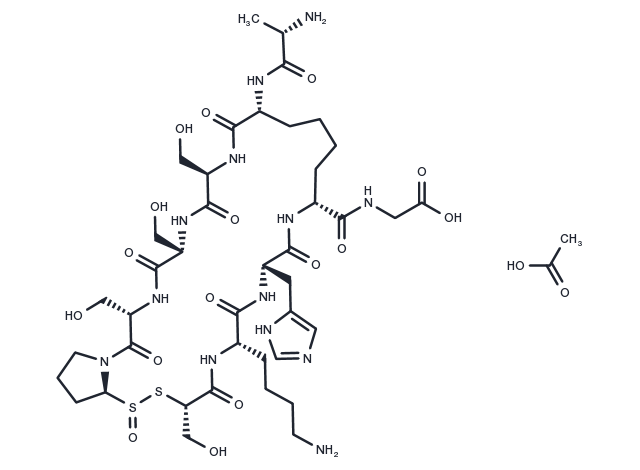keep away from moisture
Powder: -20°C for 3 years | In solvent: -80°C for 1 year

Transdermal Peptide acetate(888486-23-5 free base) (TD 1 (peptide) acetate) is a 11-amino acid peptide, binds toNa+/K+-ATPase beta-subunit (ATP1B1), and mainly interacts with the C-terminus of ATP1B1. Transdermal Peptide can enhance the transdermal delivery of many macromolecules.Transdermal Peptide TD 1 Amide is novel peptide designed to enhance transdermal drug delivery.

| Pack Size | Availability | Price/USD | Quantity |
|---|---|---|---|
| 1 mg | In stock | $ 78.00 | |
| 5 mg | In stock | $ 171.00 | |
| 10 mg | In stock | $ 263.00 | |
| 25 mg | In stock | $ 475.00 | |
| 50 mg | In stock | $ 695.00 | |
| 100 mg | In stock | $ 988.00 | |
| 500 mg | In stock | $ 1,980.00 |


| Description | Transdermal Peptide acetate(888486-23-5 free base) (TD 1 (peptide) acetate) is a 11-amino acid peptide, binds toNa+/K+-ATPase beta-subunit (ATP1B1), and mainly interacts with the C-terminus of ATP1B1. Transdermal Peptide can enhance the transdermal delivery of many macromolecules.Transdermal Peptide TD 1 Amide is novel peptide designed to enhance transdermal drug delivery. |
| In vitro | In the presence of Transdermal Peptide, because of the specific binding of Transdermal Peptide to ATP1B1, cells will upregulate the level of ATP1B1 to maintain function and structure; as a result, the expression of ATP1B1 increases. However, as time goes on, some Transdermal Peptide molecules may be transported into cells by endocytosis; consequently, the expression of ATP1B1 then decreases. The interaction between Transdermal Peptide and ATP1B1 changes not only the expression of ATP1B1, but also the localization of ATP1B1 and then the structure of the epidermal layer. This interaction can be attenuated by inhibitors or competitors, which would result in the reduced delivery of macromolecular drugs across the skin[1]. |
| Synonyms | TD 1 (peptide) acetate, Transdermal Peptide Disulfide Acetate (888486-23-5 free base) |
| Molecular Weight | 1121.2 |
| Formula | C42H68N14O18S2 |
| CAS No. | TP1033L |
keep away from moisture
Powder: -20°C for 3 years | In solvent: -80°C for 1 year
DMSO: 2.5 mM
You can also refer to dose conversion for different animals. More
bottom
Please see Inhibitor Handling Instructions for more frequently ask questions. Topics include: how to prepare stock solutions, how to store products, and cautions on cell-based assays & animal experiments, etc.
Transdermal Peptide Disulfide Acetate TP1033L Membrane transporter/Ion channel ATPase Transdermal Peptide acetate(888486235 free base) Transdermal Peptide acetate(888486 23 5 free base) TD 1 (peptide) Acetate TD 1 (peptide) acetate Transdermal Peptide Disulfide Acetate (888486-23-5 free base) inhibitor inhibit
